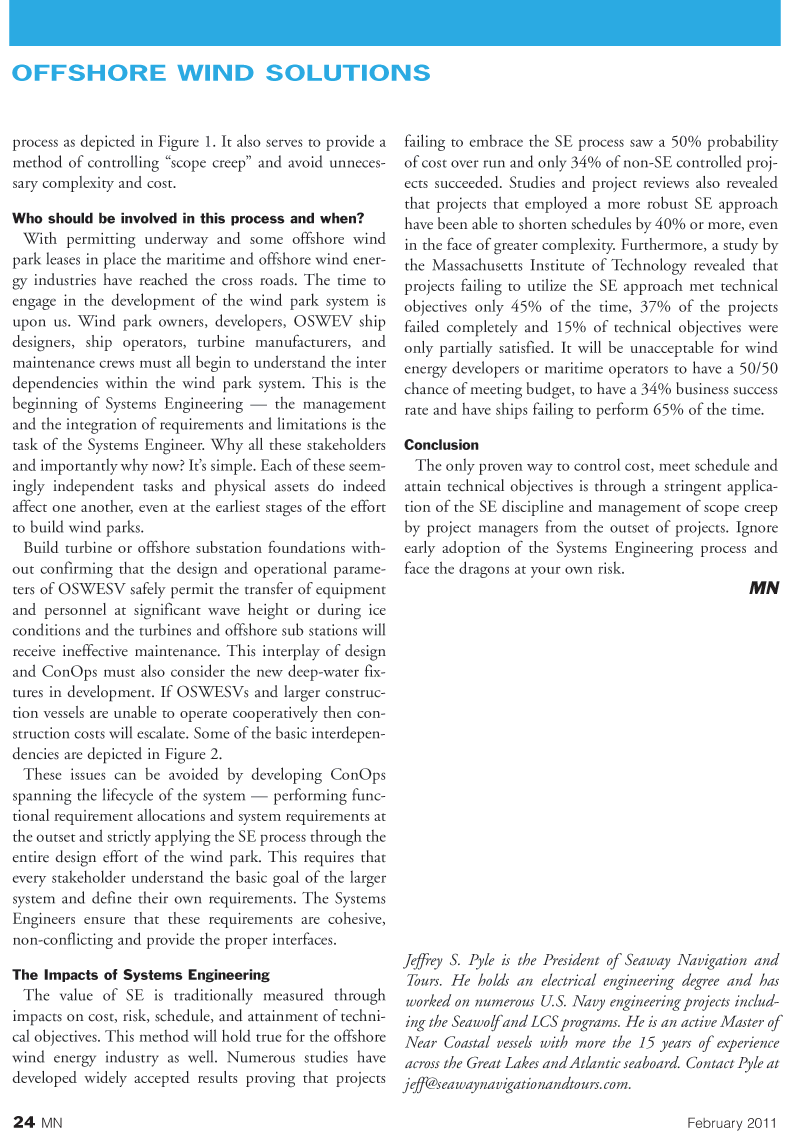
Page 24: of Marine News Magazine (February 2011)
Inland Waterways
Read this page in Pdf, Flash or Html5 edition of February 2011 Marine News Magazine
24 MN February 2011 process as depicted in Figure 1. It also serves to provide a method of controlling “scope creep” and avoid unneces- sary complexity and cost.
Who should be involved in this process and when?
With permitting underway and some offshore wind park leases in place the maritime and offshore wind ener- gy industries have reached the cross roads. The time to engage in the development of the wind park system is upon us. Wind park owners, developers, OSWEV ship designers, ship operators, turbine manufacturers, and maintenance crews must all begin to understand the inter dependencies within the wind park system. This is the beginning of Systems Engineering — the management and the integration of requirements and limitations is the task of the Systems Engineer. Why all these stakeholders and importantly why now? It’s simple. Each of these seem- ingly independent tasks and physical assets do indeed affect one another, even at the earliest stages of the effort to build wind parks.
Build turbine or offshore substation foundations with- out confirming that the design and operational parame- ters of OSWESV safely permit the transfer of equipment and personnel at significant wave height or during ice conditions and the turbines and offshore sub stations will receive ineffective maintenance. This interplay of design and ConOps must also consider the new deep-water fix- tures in development. If OSWESVs and larger construc- tion vessels are unable to operate cooperatively then con- struction costs will escalate. Some of the basic interdepen- dencies are depicted in Figure 2.
These issues can be avoided by developing ConOps spanning the lifecycle of the system — performing func- tional requirement allocations and system requirements at the outset and strictly applying the SE process through the entire design effort of the wind park. This requires that every stakeholder understand the basic goal of the larger system and define their own requirements. The Systems
Engineers ensure that these requirements are cohesive, non-conflicting and provide the proper interfaces.
The Impacts of Systems Engineering
The value of SE is traditionally measured through impacts on cost, risk, schedule, and attainment of techni- cal objectives. This method will hold true for the offshore wind energy industry as well. Numerous studies have developed widely accepted results proving that projects failing to embrace the SE process saw a 50% probability of cost over run and only 34% of non-SE controlled proj- ects succeeded. Studies and project reviews also revealed that projects that employed a more robust SE approach have been able to shorten schedules by 40% or more, even in the face of greater complexity. Furthermore, a study by the Massachusetts Institute of Technology revealed that projects failing to utilize the SE approach met technical objectives only 45% of the time, 37% of the projects failed completely and 15% of technical objectives were only partially satisfied. It will be unacceptable for wind energy developers or maritime operators to have a 50/50 chance of meeting budget, to have a 34% business success rate and have ships failing to perform 65% of the time.
Conclusion
The only proven way to control cost, meet schedule and attain technical objectives is through a stringent applica- tion of the SE discipline and management of scope creep by project managers from the outset of projects. Ignore early adoption of the Systems Engineering process and face the dragons at your own risk.
MN
Jeffrey S. Pyle is the President of Seaway Navigation and
Tours. He holds an electrical engineering degree and has worked on numerous U.S. Navy engineering projects includ- ing the Seawolf and LCS programs. He is an active Master of
Near Coastal vessels with more the 15 years of experience across the Great Lakes and Atlantic seaboard. Contact Pyle at [email protected].
OFFSHORE WIND SOLUTIONS

 23
23

 25
25
